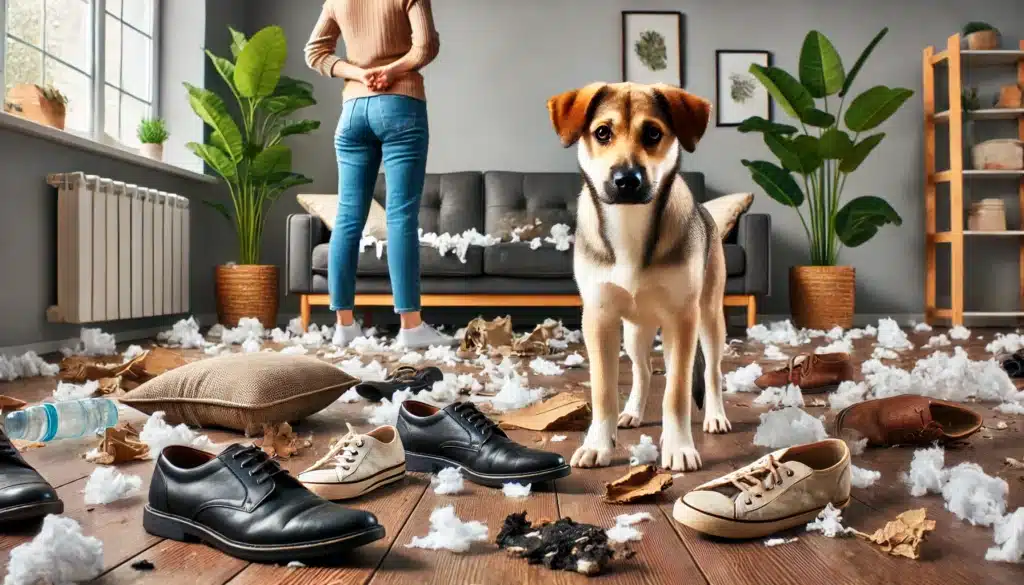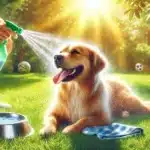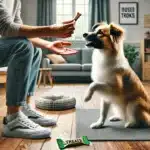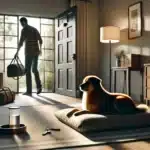Coming home to torn-up pillows, chewed furniture, shredded shoes, or trash scattered across the kitchen can feel frustrating — even infuriating. But if your dog is being destructive, it’s important to understand that it’s not about revenge or being “bad”. Destructive behavior is often a symptom, not the core issue.
In this article, we’ll explore the most common reasons why dogs destroy things, how to identify the root cause, and proven steps to redirect that energy in healthy, manageable ways.
Destructive Behavior: A Sign, Not a Personality
Destructive behavior isn’t about disobedience. It’s a form of communication.
Dogs chew, dig, rip, or destroy when they are:
- Bored
- Anxious
- Overstimulated
- Under-exercised
- Confused
- Seeking attention
Understanding the why behind the behavior is the key to fixing it.
Common Types of Destructive Behavior
| Behavior | Possible Cause |
|---|---|
| Chewing shoes or furniture | Boredom, teething, anxiety |
| Shredding paper or pillows | Play, hunting instinct, stress |
| Digging in the yard | Instinct, energy, trying to escape |
| Scratching doors or windows | Separation anxiety |
| Tearing up toys | Normal play or frustration |
| Raiding the trash | Hunger, boredom, smell stimulation |
Step 1: Rule Out Medical Issues
Before labeling your dog as “destructive,” check for medical causes. Pain, cognitive decline (especially in seniors), or digestive issues can lead to unexpected behaviors.
Consult your veterinarian if:
- The behavior starts suddenly
- It happens during rest periods
- Your dog shows signs of illness or pain
Step 2: Identify the Root Cause
🐾 Is it Boredom?
Dogs need stimulation. Without it, they make their own fun — often at your expense.
Fix:
- More physical activity (walks, fetch, agility)
- Mental stimulation (puzzle toys, sniff games)
- Training games and new tricks
🏠 Is it Separation Anxiety?
Destruction focused near doors or windows, combined with whining, pacing, or bathroom accidents, may signal anxiety when you’re away.
Fix:
- Desensitization to departures
- Calming aids
- Gradual alone-time training
- Vet or trainer support for severe cases
🧸 Is it Normal Puppy Behavior?
Puppies explore the world with their mouths — and they teethe, just like human babies.
Fix:
- Offer safe teething toys
- Freeze carrots or puppy chew toys for relief
- Use crates or pens for supervised freedom
- Puppy-proof your home
💡 Is it Lack of Boundaries or Training?
If your dog doesn’t know what not to do, they’ll just follow their instincts.
Fix:
- Teach “Leave it,” “Drop it,” and “Go to your bed”
- Supervise and redirect
- Reward calm behavior
Step 3: Control the Environment
Until your dog learns better habits, limit their access to temptation.
- Use baby gates or exercise pens
- Store shoes, remotes, and trash out of reach
- Remove access to unsupervised rooms
- Provide plenty of chewable alternatives
Set your dog up for success, not failure.
Step 4: Redirect and Reinforce the Right Behavior
✅ Do:
- Catch them in the act and calmly redirect to a toy
- Reward when they choose the correct item to chew or play with
- Use “Yes!” or a clicker the moment they make the right choice
- Encourage independence through crate training or place training
❌ Don’t:
- Punish after the fact (your dog won’t understand why)
- Scold when they come to you with guilt — they’re reacting to your tone, not the action
- Force them to interact with destroyed items (e.g., “rub their nose in it” — this damages trust)
Step 5: Offer Better Alternatives
Dogs need to chew, dig, and shred — so give them ways to do it safely.
🧠 Great options:
- Kong toys stuffed with food
- Rope toys
- Puzzle feeders
- Frozen lick mats
- Chew sticks or dental bones
- Sandboxes for digging breeds
- Cardboard boxes filled with paper for supervised shredding fun
Rotate toys regularly to keep things interesting.
Step 6: Increase Exercise and Mental Work
Destruction often disappears when dogs are mentally and physically fulfilled.
Aim for:
- Daily walks: 30–60 minutes depending on breed and age
- Play sessions: Fetch, tug, flirt pole
- Training sessions: 5–10 minutes of obedience or trick work
- Solo play: Chew toys, puzzle feeders, frozen Kongs
Remember: a tired dog is a good dog.
Step 7: Use Tools and Techniques That Work
- Crate training: Helps build calm independence and prevents mischief when unsupervised
- Dog-proof rooms: Safe zones with toys and bedding
- Dog walkers or daycare: Great for high-energy dogs when you’re away
- Taste deterrent sprays: Use on furniture legs or cables, paired with redirection
When to Seek Professional Help
Call in a vet or certified dog trainer if:
- Destruction is severe or dangerous
- It causes injury to your dog or damage to your home
- It’s tied to aggression or extreme anxiety
- You’ve tried everything and it’s getting worse
Behavior modification and medical evaluation may be needed for long-term success.
Final Thoughts: Your Dog Isn’t Trying to Upset You
Destructive dogs aren’t “bad” — they’re bored, confused, or anxious. With a little detective work, consistency, and positive redirection, you can teach your dog better habits and build a stronger relationship along the way.
Set clear boundaries, offer the right outlets, and celebrate progress — even the small wins. A well-behaved dog is made, not born.







